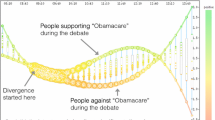Abstract
Journalists, government agency and the public may hold different opinions about the same event; these opinions flow within and across multiple social groups. Understanding opinion flow in multiple social groups is conducive to have a quick grasp of the information on social media. Our study aims to explore the opinion flow within or across the pre-defined social groups and the mutual influence of these groups’ views about the same event. First of all, to depict the opinion flow, we propose a topic transition model, and for expressing the interaction of groups’ opinion, we propose a quantitative approach. Secondly, according to 4Ws, we design a visual analytic system to let users analyze public opinion events through our system. The visual interface is tightly coupled with the analytical methods to present a concise summary of the opinion flow of events. A novel forwarding-network slicing diagram is designed to depict the forwarding process. To describe the result of the topic transition model, we also propose a topic transition graph to characterize the opinion flow. And a novel glyph is designed to visualize the characteristic of the influence. Our system provides a variety of interactions to assist users in exploring data, and we demonstrate the functionality of the system through two case studies.
Graphic Abstract










Similar content being viewed by others
References
Blei DM, Lafferty JD (2006) Dynamic topic models, pp 113–120
Bryan C, Ma K-L, Woodring J (2017) Temporal summary images: an approach to narrative visualization via interactive annotation generation and placement. IEEE Trans Vis Comput Graph 23:511–520
Cao J, Zhang Y-D, Li J-T, Tang S (2008) A method of adaptively selecting best LDA model based on density. Chin J Comput 31:1780–1787
Chen S, Lin L, Yuan X (2017) Social media visual analytics, pp 563–587
Cho I, Wesslen R, Volkova S, Ribarsky W, Dou W (2017) Crystalball: a visual analytic system for future event discovery and analysis from social media data, pp 25–35
Cui W, Liu S, Wu Z, Wei H (2014) How hierarchical topics evolve in large text corpora. IEEE Trans Vis Comput Graph 20:2281–2290
D’Andrade R, Egan M (1974) The colors of emotion 1. Am Ethnol 1:49–63
Dou W, Wang X, Chang R, Ribarsky W (2011) Paralleltopics: a probabilistic approach to exploring document collections, pp 231–240
Dou W, Wang X, Skau D, Ribarsky W, Zhou MX (2012) Leadline: interactive visual analysis of text data through event identification and exploration, pp 93–102
Dou W, Yu L, Wang X, Ma Z, Ribarsky W (2013) Hierarchicaltopics: visually exploring large text collections using topic hierarchies. IEEE Trans Vis Comput Graph 19:2002–2011
Ganesan A, Brantley K, Pan S, Chen J (2015) Ldaexplore: visualizing topic models generated using latent Dirichlet allocation. arXiv:150706593
Heimerl F, Han Q, Koch S, Ertl T (2016) CiteRivers: visual analytics of citation patterns. IEEE Trans Vis Comput Graph 22:190–199
Hofmann T (2001) Unsupervised learning by probabilistic latent semantic analysis. Mach Learn 42:177–196
Hu M, Wongsuphasawat K, Stasko J (2017) Visualizing social media content with sententree. IEEE Trans Vis Comput Graph 23:621–630
Jakubiec FY, Ribeiro A (2013) D-map: distributed maximum a posteriori probability estimation of dynamic systems. IEEE Trans Signal Process 61:450–466
Karpovich S, Smirnov A, Teslya N, Grigorev A (2017) Topic model visualization with ipython, pp 131–137
Li G, Chen J (2014) A review of network public opinion for unexpected emergency. Doc Inf Knowl 2:111–119
Littman J (2018) Charlottesville tweet ids. Harvard Dataverse. https://doi.org/10.7910/DVN/DVLJTO
Littman J, Wrubel L, Kerchner D, Bromberg Gaber Y (2017) News outlet tweet ids. Harvard Dataverse. https://doi.org/10.7910/DVN/2FIFLH
Liu S, Cui W, Wu Y, Liu M (2014) A survey on information visualization: recent advances and challenges. Vis Comput 30:1373–1393
McCombs ME, Shaw DL, Weaver DH (2014) New directions in agenda-setting theory and research. Mass Commun Soc 17:781–802
Postman N (1985) Amusing ourselves to death etc. Rev Gen Semant 42:13–18
Ren D, Zhang X, Wang Z, Li J, Yuan X Weiboevents (2014) A crowd sourcing weibo visual analytic system, pp 330–334
Summers E (2017) Puerto Rico tweets. Internet Archive
Sun G, Wu Y, Liu S, Peng T-Q, Zhu JJH, Liang R (2014) EvoRiver: visual analysis of topic coopetition on social media. IEEE Trans Vis Comput Graph 20:1753–1762
Sun G, Tang T, Peng T-Q, Liang R, Wu Y (2017) SocialWave: visual analysis of apatio-temporal diffusion of information on social media. ACM Trans Intell Syst Technol 9:1–13
Wang X, Liu S, Yang C, Peng TQ, Guo B (2017) How ideas flow across multiple social groups
Wang J, Wu X, Li L (2018) A framework for semantic connection based topic evolution with DeepWalk. Intell Data Anal 22:211–237
Wu Y, Liu S, Yan K, Liu M, Wu F (2014) Opinionflow: visual analysis of opinion diffusion on social media. IEEE Trans Vis Comput Graph 20:1763–1772
Wu Y, Cao N, Gotz D, Tan YP, Keim DA (2016) A survey on visual analytics of social media data. IEEE Trans Multimed 18:2135–2148
Wu Y, Chen Z, Sun G et al (2017) StreamExplorer: a multi-stage system for visually exploring events in social streams. IEEE Trans Vis Comput Graph 24(10):2758–2772
Xu P, Wu Y, Wei E, Peng T-Q, Liu S, Zhu JJH, Qu H (2013) Visual analysis of topic competition on social media. IEEE Trans Vis Comput Graph 19:2012–2021
Zhang JS, Lv Q (2019) Understanding event organization at scale in event-based social networks. ACM Trans Intell Syst Technol 10:16–16
Zhang Y, Mao W, Lin J (2017) Modeling topic evolution in social media short texts, pp 315–319
Acknowledgements
We greatly appreciate the feedback from anonymous reviews. This work was supported by National NSF of China (No. 61702359).
Author information
Authors and Affiliations
Corresponding author
Additional information
Publisher's Note
Springer Nature remains neutral with regard to jurisdictional claims in published maps and institutional affiliations.
Rights and permissions
About this article
Cite this article
Ma, C., Zhang, Y., Robert, NE. et al. Visual analysis of the opinion flow among multiple social groups. J Vis 23, 507–521 (2020). https://doi.org/10.1007/s12650-019-00615-z
Received:
Accepted:
Published:
Issue Date:
DOI: https://doi.org/10.1007/s12650-019-00615-z




